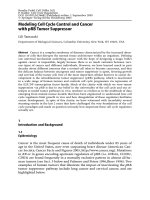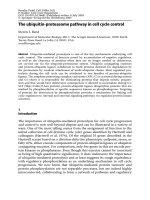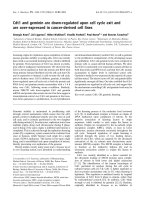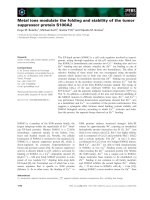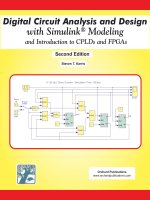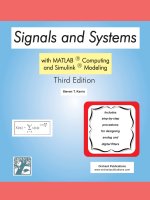Modeling Cell Cycle Control and Cancer with pRB Tumor Suppressor
Bạn đang xem bản rút gọn của tài liệu. Xem và tải ngay bản đầy đủ của tài liệu tại đây (348.04 KB, 30 trang )
Results Probl Cell Differ (42)
P. Kaldis: Cell Cycle Regulation
DOI 10.1007/b136682/Published online: 1 September 2005
© Springer-Verlag Berlin Heidelberg 2005
Modeling Cell Cycle Control and Cancer
with pRB Tumor Suppressor
Lili Yamasaki
Department of Biological Sciences, Columbia University, New York, NY 10027, USA
Abstract Cancer is a complex syndrome of diseases characterized by the increased abun-
dance of cells that disrupts the normal tissue architecture within an organism. Defining
one universal mechanism underlying cancer with the hope of designing a magic bullet
against cancer is impossible, largely because there is so much variation between vari-
ous types of cancer and different individuals. However, we have learned much in past
decades about different journeys that a normal cell takes to become cancerous, and that
the delicate balance between oncogenes and tumor suppressor is upset, favoring growth
and survival of the tumor cell. One of the most important cellular barriers to cancer de-
velopment is the retinoblastoma tumor suppressor (pRB) pathway, which is inactivated
in a wide range of human tumors and controls cell cycle progression via repression of
the E2F/DP transcription factor family. Much of the clarity with which we view tumor
suppression via pRB is due to our belief in the universality of the cell cycle and our at-
tempts to model tumor pathways in vivo, nowhere so evident as in the multitude of data
emerging from mutant mouse models that have been engineered to understand how cell
cycle regulators limit growth in vivo and how deregulation of these regulators facilitates
cancer development. In spite of this clarity, we have witnessed with incredulity several
stunning results in the last 2 years that have challenged the very foundations of the cell
cycle paradigm and made us question seriously how important these cell cycle regulators
actually are.
1
Introduction and Background
1.1
Epidemiology
Cancer is the most frequent cause of death of individuals under 85 years of
age in the United States, now even surpassing heart disease (American Can-
cer Society, Cancer Facts and Figures 2005, ). Mutations
in RB or in genes encoding upstream regulators of pRB (i.e. INK4A, CCND1,
CDK4) are found frequently in a mutually exclusive pattern in almost all hu-
man tumors (see Sect. 3 below and Palmero and Peters 1996,Sherr 1996). Two
examples of human tumors that illustrate the impact of inactivating the pRB
tumor suppressor pathway include lung cancer and cervical cancer, and are
highlighted below.
228 L. Yamasaki
The most frequent types of cancer diagnosed in the United States in de-
creasing incidence are breast cancer, prostate cancer, lung cancer and colon
cancer; yet lung cancer is the deadliest form of cancer in the United States
(163 500 deaths annually and 172 500 new cases annually). Twenty percent
of lung cancer is classified as SCLC (small-cell lung cancer; 32 700 deaths
annually); the vast majority (∼ 90%) of cases carry mutations that directly
inactivate the RB locus (encoding pRB)(Kaye 2002, Minna et al. 2004). It is in-
deed sobering to consider the number of deaths due to lung cancer that are
largely preventable with abstinence from or cessation of smoking, and the fact
that while smoking is on the decline in the United States, smoking and its as-
sociated lung cancer has been exported heavily to the developing world in the
past 30 years. Moreover, the list of cancers for which smoking is a causative
factor has grown to include cancers of the respiratory, gastrointestinal and
genitourinary tracts (US Department of Health and Human Services, Surgeon
General’s Report on Smoking, ).
Human cancer caused by viral infection remains a significant cause of
suffering and death worldwide. Human papillomavirus (HPV) infection is
a prominent sexually transmitted disease (20 million infected in the United
States and 630 million infected worldwide), and its striking association
(∼ 99%) with cervical cancer (15 000 new cases annually in the US and
470 000 new cases annually worldwide) is most prevalent in the develop-
ing world where screening (i.e. Pap smear) is not routinely performed (zur
Hausen 2002 and World Health Organization, ). The asso-
ciation of high-risk HPV (types 16 and 18) with cervical cancer is due to its
ability to inactivate pRB growth suppression by direct binding of the HPV-E7
oncoprotein to pRB. Although a substantial time after primary viral infection
is observed before cancer develops, the evidence that HPV causes cervical
cancer is strong enough to classify it as a carcinogen by IARC (International
Agency for Research on Cancer) and by the Federal Department of Health and
Human Services.
1.2
Modeling Human Cancer in the Mouse
The ability of researchers to model cancer has grown substantially in the past
decade, particularly in the mouse, in which numerous models of tumor devel-
opment are now available for study. The eventual goals of such modeling are
to faithfully reproduce the complexity of human tumorigenesis in the model
organism, and then exploit the model system to uncover the regulatory points
or Achilles heel of cancer, such that new therapies can be designed to at-
tack the clinical disease. The many engineered strains of mutant mice have
provided an excellent genetic model system in which to pursue these goals,
and in fact, our efforts to model human cancer in the mouse, are far from
exhaustive.
Modeling Cell Cycle Control and Cancer with pRB Tumor Suppressor 229
Many transgenic mice overexpressing an oncogene of interest have been
made using tissue-specific promoters (e.g. MMTV LTR for breast, keratin 14
promoter for skin, and CD4 promoter for T-cells) to model a particular form
of cancer. Knockout mice lacking specific tumor suppressors have been en-
gineered to define the requirement of these genes during development and
for inhibition of tumor development throughout life. Multistep tumorigenesis
can be studied by treating these mutant mice with carcinogens, by combin-
ing such transgenic mice with knockout mice or by using proviral tagging to
enhance the frequency or severity of specific cancers. Of course, the ability
to generate these mice from genetically pure or inbred backgrounds, and to
examine time points during embryogenesis or life after birth gives us greater
insight into the different mechanisms of tumor development than that pos-
sible from studying human tumors alone. Additionally, mutation of tumor
suppressors in mice leads to a restricted set of tumor types analogous to the
narrow spectrum of tumors seen in inherited human tumor syndromes, the
mechanistic basis for which is still elusive.
Nowhere has hope for modeling cancer in the mouse been as great as in
the large number of mutants engineered in genes encoding components of
the cell cycle machinery and the pRB and p53 tumor suppressor pathways.
The universality of the cell cycle in all eukaryotes strongly suggested that anti-
cancer therapy aimed at regulators of the cell cycle would be of great clinical
benefit. This review will discuss the phenotypes of such mutant mice and
the surprising recent results that suggest the cell cycle paradigm may greatly
underestimate the complexity of the wiring of the cell cycle at least during
embryonic development (see Sect. 5 below).
While the existing mutant mouse models of cancer are both impressive and
powerful, they do not necessarily reflect the spectrum or complexity of hu-
man cancer. Only a small amount of human cancer can be attributed to the
inheritance of dominantly acting mutant alleles of known tumor suppressors
(Balmain et al. 2003). It has been estimated that only 12%ofhumanbreast
cancer patients carry mutations in either the BRCA1 or the BRCA2 tumor sup-
pressor gene, and that the majority of human, cancer susceptibility is due to
the combined action of common, low penetrance cancer predisposing alleles
or genetic modifiers of tumor susceptibility that have not yet been identi-
fied (Pharoah et al. 2002). Recently, the Stk6 locus encoding the Aurora-2
centrosome-associated kinase was identified as a weak modifier of skin tu-
morigenesis in mice, and a polymorphism in the human Aurora homologue,
STK15 (Phe311), is found frequently amplified in human colon cancer (Ewart-
Toland et al. 2003). Eventually, the hope is that as mutant mouse models of
cancer improve, we can pursue more of these weak tumor predisposing al-
leles, for instance, by using our dominantly acting mutant mouse models of
cancer to screen for enhancers or suppressors of these phenotypes. Perhaps
only then can more clinically relevant and beneficial information be forth-
coming from mutant mouse models of cancer.
230 L. Yamasaki
2
The Universality of the Cell Cycle
The discovery of the cell cycle emerged from distinct studies in yeast,
flies, clams, and frogs, and eventually the conclusions drawn were tested
and found to be operative also in mice and humans. The power of the
cell cycle theory is that it unified eukaryotic biology, for which Hartwell,
Nurse and Hunt were recognized with the Nobel Prize in Medicine in 2001
( The model of the cell cycle
has given researchers the chance to understand complex mammalian systems
and human disease, using genetic studies in evolutionarily lower organisms.
From studying temperature sensitive cdc mutants of budding yeast (Sac-
charomyces cerevisiae) with abnormal budded morphology at the non-
permissive temperature, Hartwell and colleagues proposed that a simple
order of dependent events (e.g. budding, DNA synthesis, cytokinesis), com-
pletion of which were necessary for cell division. In this way, the many of
the primary components of the cell division cycle were identified and placed
in a genetic pathway, in particular, Cdc28, which held precedence over all
the cdc mutants as a master regulator in G1. Importantly, this work initiated
the concept of checkpoints, non-essential genes that ensure these fundamen-
tal processes were completed. Nurse and co-workers built on these seminal
concepts using fission yeast (S. pombe), first identifying temperature sensi-
tive wee1 mutants and then Cdc2 as a master regulator of the cell cycle in
G2/M. Nurse showed that Cdc2 was required also in G1, and complementa-
tion experiments then showed that Cdc2 was the S. pombe homologue of the
S. cerevisiae Cdc28 regulator. The identification of Cdc28 and then Cdc2 as
kinases, helped define the function of other cdc genes (e.g. Cdc25 and Wee1)
that modify the kinase activity of these master switches. Importantly, Masui’s
early studies of MPF (maturation promoting factor) activation in frog oocytes
were crucial for understanding the commonality of these mechanisms even in
vertebrates. Nurse and colleagues then cloned human Cdc2 through comple-
mentation of the yeast cdc2 mutant.
By studying changes in protein expression ongoing in the fertilization of
clam and sea urchin eggs, Hunt and colleagues identified the first cyclin pro-
teins, the abundance of which fluctuates with the division of the eggs. The
identification of classes of yeast cyclins (Clns in G1 and Clbs in G2) that
control Cdc28 and classes of vertebrate cyclins (D- and E-type cyclins in G1
and A-and B-type cyclins in G2/M) that control a family of Cdks (cyclin-
dependent kinases) greatly enhanced our understanding of the complexity
underlying control of the cell cycle. Control of Cdk activity through cyclin
binding and degradation, inhibitory and activating Cdk phosphorylations
and association of Cdk inhibitors outlined a range of regulatory mechanisms
for controlling cell cycle progression (Morgan 1997; Zachariae and Nasmyth
1999). These studies and others demonstrated the universality of the cell
Modeling Cell Cycle Control and Cancer with pRB Tumor Suppressor 231
cycle, and strongly suggested that deregulation of the mechanisms controlling
cell cycle progression could result in cancer.
3
The pRB Tumor Suppressor Pathway
The concept that chromosomes could suppress malignancy is attributed to
Boveri’s writings from 1914 (Balmain 2001; Knudson 2001). In 1969, so-
matic cell hybridization experiments between normal and transformed cells
resulted in phenotypically normal hybrids that often reverted to being trans-
formed, indicating the existence of cellular genes that normally suppressed
transformation (Ephrussi et al. 1969). Below is outlined the compelling evi-
dence that the pRB tumor suppressor pathway is a crucial target that must be
inactivated during the progression of normal cells into tumors.
3.1
The Discovery of pRB
Thepathofdiscoveryfortheprototypictumorsuppressor,RB, has been
repeated many times with the identification of human tumor suppressors,
mutation of which leads to cancer development. In 1971, Knudson consid-
ered the clear differences between the clinical presentation of inherited and
sporadic retinoblastoma cases (i.e. frequency, age of onset, unilateral vs. bi-
lateral, unifocal vs. multifocal lesions), and proposed the “two-hit” hypothesis
for pediatric retinoblastoma development that put forward the following ex-
planation for these clinical differences (Knudson 1971). Inherited retinoblas-
toma patients must carry a germ-line loss-of-function mutation in a putative
retinoblastoma tumor suppressor gene (RB), and sometime during develop-
ment or shortly after birth, a somatically acquired mutation specifically in
a few retinal cells would inactivate the remaining normal RB allele, giving rise
to multiple retinoblastomas per patient. In contrast, sporadic retinoblastoma
patients must acquire two somatic RB mutations within the same retinal cell,
an extremely rare event, giving rise to a single retinoblastoma per patient.
The later identification of cytogenetic abnormalities involving deletions of
Chr13q14 in normal blood cells from inherited retinoblastoma patients and
in sporadic retinoblastoma tumor samples, strongly suggested the location of
the RB gene, facilitating its subsequent positional cloning of the RB gene in
1986. Shortly thereafter, RB mutations were found frequently in osteosarco-
mas, small cell lung carcinomas and carcinomas of the prostate, bladder and
breast. It has been estimated that 40–50% of human tumors contain direct
inactivation of the RB gene (Palmero and Peters 1996; Sherr 1996).
Importantly, re-expression of pRB in tumor cells can revert the trans-
formed phenotype (Huang et al. 1988), giving support for cancer therapies
232 L. Yamasaki
that restore pRB function. In 1988, interactions of pRB with viral oncopro-
teins from three distinct DNA tumor virus families (i.e. adenovirus E1A,
SV40-T and HPV-E7) were demonstrated to be necessary for cellular trans-
formation by these viruses (DeCaprio et al. 1988; Dyson et al. 1989). Binding
of viral oncoproteins requires a large central region of pRB, known as the
“pocket” domain, and tumor-derived RB mutants often had sustained dele-
tions of exons encoding pieces of this “pocket” region of pRB. Two pRB ho-
mologues (p107 and p130) have been identified that show extensive homology
through the central “pocket” domain of pRB and also to each other (reviewed
in Classon and Harlow 2002). Although both pRB homologues can inhibit
growth when overexpressed, mutations in genes encoding p107 or p130 are
only rarely found in human tumors, and thus, these pRB homologues are not
generally considered to be human tumor suppressors. Importantly, pRB sup-
presses growth and promotes lineage-specific differentiation; yet p107 and
p130 appear to act together to suppress growth. It may be important to re-
assess the status of p107 and p130 mutations in tumors bearing RB mutations,
given the recent evidence that these pRB family members act as tumor sup-
pressors in conjunction with pRB (see Sect. 7).
3.2
Upstream Regulators of pRB
Cell cycle-dependent phosphorylation of pRB occurs in G1 by cyclin-
dependent kinases that sequentially inactivate the tumor suppressive prop-
erties of pRB. Hyper-phosphorylation of pRB prevents binding of viral
oncoproteins and cellular proteins to the central “pocket” region of pRB.
Non-phosphorylatable pRB mutants suppress growth more efficiently than
wild-type pRB. Normally, D-type cyclin/Cdk4 or cyclin/Cdk6 complexes
phosphorylate pRB in early G1, while cyclin E1–2/Cdk2 complexes phos-
phorylate pRB at the G1/S transition, stimulating S-phase entry and cell
cycle progression. Overexpression of D- and E-type cyclins and Cdk4 is ob-
served frequently in human tumors (see Sect. 5), supporting the notion that
these cell cycle regulators are critical for cell cycle progression. Inactiva-
tion of the complex locus at Chr9p21 containing the INK4A gene encoding
p16, the cyclin-dependent kinase inhibitor specific for Cdk4 or Cdk6, is com-
monly seen in about half of human tumors (for discussion of the ARF tumor
suppressor also residing at Chr9p21, see Sect. 6). Mutation of genes encod-
ing these upstream regulators of pRB is observed in approximately 50%of
all human tumors, in a mutually exclusive pattern to those tumors carry-
ing RB mutations (Palmero and Peters 1996; Sherr 1996). Thus, inactivation
of the pRB tumor suppressor pathway directly (RB mutations) or indirectly
(CCND1, INK4A or CDK4 mutations) occurs in almost all human tumors, em-
phasizing the importance of overcoming pRB-mediated growth control for
tumor progression.
Modeling Cell Cycle Control and Cancer with pRB Tumor Suppressor 233
Two classes of human tumors that do not contain mutations of RB or muta-
tions in genes encoding upstream regulators of pRB have derived other ways
to circumvent the pRB tumor suppressor pathway. Colon carcinomas increase
transcription of CCND1 via increases in β-catenin/TCF signaling resulting
from loss of the APC tumor suppressor (Tetsu and McCormick 1999). Neu-
roblastomas increase transcription of Id2 via amplification of N-MYC that
antagonizes pRB-mediated tumor suppression (Lasorella et al. 2000, and see
Sect. 3.4).
3.3
Phenotype of Mice Lacking pRB Family Members
Mice lacking pRB die in mid-gestation with extensive defects in the central
and peripheral nervous systems, fetal liver and lens (Clarke et al. 1992; Jacks
et al. 1992; Lee et al. 1992) (Table 1). Chimaeras made with Rb-deficient ES
cells develop surprisingly well, demonstrating that many tissues do not re-
quire pRB for normal function (Maandag et al. 1994; Williams et al. 1994b).
Bypass of the mid-gestational lethality in Rb-deficient embryos allowed de-
fects in muscle differentiation to be observed later in development (Zacksen-
haus et al. 1996). The extensive apoptosis evident in the Rb-deficient embryos
has now been shown to be due to placental insufficiency, specifically due
to the hyperproliferation of the spongiotrophoblast layer of the placenta at
E11.5 (Wu et al. 2003). Hyperproliferative and/or differentiation defects in
the CNS, lens, and muscle are still present in Rb-deficient embryos once the
placental requirement for Rb is circumvented through the use of chimaeras or
through conditional deletion of Rb (Lipinski et al. 2001; Ferguson et al. 2002;
de Bruin et al. 2003; MacPherson et al. 2003). Similarly, erythropoietic de-
fects are apparent in the fetal liver of Rb-deficient embryos, and Rb-deficient
erythroblasts fail to fully mature in vitro or reconstitute irradiated wild-type
donors (Iavarone et al. 2004; Spike et al. 2004).
Rb+/- mice develop neuroendocrine tumors of the pituitary, thyroid, and
adrenals (Jacks et al. 1992; Hu et al. 1994; Harrison et al. 1995) (Table 2).
Neuroendocrine tumorigenesis in Rb+/- mice is dependent on LOH of the
wild-type Rb allele similar to the retinoblastomas and osteosarcomas de-
veloping in germ-line retinoblastoma patients. This system has been used
extensively to test the functional significance of numerous cell cycle regula-
tors and interactors of pRB, including E2F family members and CKIs (Table 1
and Sects. 3.4 and 4). Interestingly, the spectrum of neuroendocrine tumors
observed in Rb+/- mice is dependent on strain-specific modifiers, and specif-
ically, inherent abnormalities of the 129Sv strain enhance the development of
tumors in the intermediate lobe of the pituitary (Leung et al. 2004).
In contrast to phenotypes of the Rb mutant mice, p107-deficient or p130-
deficient mice live to be viable adults without tumor predisposition on
a mixed genetic background with the C57LB/6 strain (Cobrinik et al. 1996;
234 L. Yamasaki
Table 1 Phenotypes of mice lacking Rb family members and rescue of Rb deficiency
Genotype Phenotype References
Rb–/– Mid-gestational lethality at (Clarke et al. 1992;
E13.5-E15.5 with widespread Jacks et al. 1992;
apoptosis Lee et al. 1992)
Placental bypass required for (Maandag et al. 1994;
survival to late gestation Williams et al. 1994b;
Wu et al. 2003;
Zacksenhaus et al. 1996)
Defects then found in CNS/PNS, (de Bruin et al. 2003;
fetal liver, muscle and lens Ferguson et al. 2002;
Lipinski et al. 2001;
MacPherson et al. 2003;
Spike et al. 2004)
p107–/– Myeloid hyperplasia and growth (LeCouter et al. 1998a;
deficiency on Balb/c background Lee et al. 1996)
No obvious phenotype on mixed
genetic background
p130–/– Embryonic lethality E11-E13 (Cobrinik et al. 1996;
on a Balb/c background LeCouter et al. 1998b)
No obvious phenotype on mixed
genetic background
p107–/–; p130–/– Perinatal lethality with (Cobrinik et al. 1996)
endochondral bone defects
on mixed background
Rb–/–; p107–/– Embryonic death prior to E12.5 (Lee et al. 1996)
Rb–/–; E2f1–/– Rescue of mid-gestational (Tsai et al. 1998)
lethality until late gestation
Rb–/–; E2f3–/– Rescue of mid-gestational (Ziebold et al. 2001)
lethality until late gestation
Rb–/–; Id2–/– Rescue of mid-gestational (Iavarone et al. 2004;
lethality until late gestation Lasorella et al. 2000)
and RBC enucleation in fetal liver
Rb–/–; p53–/– Reduction of cell death in CNS (Macleod et al. 1996;
and lens, but not PNS Morgenbesser et al. 1994)
Rb–/–; p19–/– No rescue of p53-dependent (Tsai et al. 2002a)
apoptosis observed
Lee et al. 1996) (Table 1). Combining p107 deficiency with p130 deficiency,
results in perinatal death with defects in endochondral bone development
(Cobrinik et al. 1996). On a 129Sv Balb/c background, p130-deficient em-
bryos die and p107-deficient animals exhibit growth and myeloproliferative
defects (LeCouter et al. 1998a,b), again suggesting that strain-specific mod-
Modeling Cell Cycle Control and Cancer with pRB Tumor Suppressor 235
Table 2 Phenotypes of Rb+/– mice lacking various cell cycle regulators
Genotype Phenotype References
Rb+/– Neuroendocrine tumorigenesis in (Harrison et al. 1995;
intermediate lobe of the pituitary Hu et al. 1994;
Jacks et al. 1992)
Additional tumorigenesis in thyroid, (Williams et al. 1994a;
anterior lobe of the pituitary, Nikitin et al. 1999)
and adrenal gland
Rb+/–; p107–/– Neuroendocrine and non-endocrine (Dannenberg et al. 2004)
tumorigenesis in chimaeras
Rb+/–; p130–/– No pituitary or thyroid (Dannenberg et al. 2004)
tumorigenesis but other
endocrine tumors at low
frequency in chimaeras
Rb+/–; E2f1–/– Decreased neuroendocrine (Yamasaki et al. 1998)
tumorigenesis and increased
survival
Rb+/–; E2f3–/– Decreased pituitary (Ziebold et al. 2003)
tumorigenesis, but worsened
thyroid tumors
Rb+/–; E2f4–/– Decreased neuroendocrine (Lee et al. 2002)
tumorigenesis and increased
survival
Rb+/–; p21–/– Increased neuroendocrine (Brugarolas et al. 1998)
tumorigenesis, including
pheochromacytomas, and
decreased survival
Rb+/–; p27–/– Increased neuroendocrine (Park et al. 1999)
tumorigenesis with worsened
thyroid tumors and decreased
survival
Rb+/–; p53–/– Increased neuroendocrine (Williams et al. 1994a)
tumorigenesis and decreased
survival
Rb+/–; p19–/– Increased neuroendocrine (Tsai et al. 2002b)
tumorigenesis and decreased
survival
Rb+/– Increased tumorigenesis (Leung et al. 2004)
(129Sv) in the intermediate lobe
of the pituitary, and
greatly decreased survival
Rb+/– Increased neuroendocrine (Leung et al. 2004)
(C57BL/6) tumorigenesis in the anterior
pituitary and thyroid glands
with increased survival
236 L. Yamasaki
ifiers regulate the severity of phenotypes resulting from inactivation of Rb
family members. While the constitutive inactivation of multiple Rb family
members is required for the immortalization of primary mouse embryonic
fibroblasts (MEFs) (Dannenberg et al. 2000; Sage et al. 2000; Peeper et al.
2001), the spontaneous loss of only Rb is sufficient to reverse cellular senes-
cence (Sage et al. 2003). Conditional loss of Rb impairs the development of
the cerebellum on a p107-deficient background (Marino et al. 2003) and pro-
ducesmedulloblastomasonap53-deficient background (Marino et al. 2000).
Chimaeras generated with ES cells that are Rb-deficient and either p107- or
p130-deficient are highly tumor prone, demonstrating that pRB family mem-
bers act in concert to suppress tumorigenesis in a wide variety of tissues in
the mouse (Dannenberg et al. 2004) (Table 2). Chimaeras generated with ES
cells that are Rb+/- and either p107- or p130-deficient develop tumors, but
suggest that p107 is a more effective tumor suppressor that p130 (Dannen-
berg et al. 2004). The absence of retinoblastoma in Rb+/- mice prompted
criticism of modeling human cancer in the mouse, but continued efforts to
generate inherited models of mouse retinoblastoma with Rb deficiency have
been successful recently (see Sect. 7 below).
3.4
pRB Regulates Growth and Differentiation
In the following section, the best characterized effector of pRB, the E2F/DP
transcription factor family, is reviewed (see Sect. 4). The ability of E2F/DP
complexes to control the expression of most if not all cell cycle related genes
strongly suggests that the E2F/DP family is a crucial, downstream pRB target
for controlling growth and thereby suppressing tumorigenesis. However, be-
yond the preponderance of reports on E2F and the significance of E2F for the
growth suppressive function of pRB, there are numerous (∼ 110) other inter-
actors of pRB that have been identified (Morris and Dyson 2001). While none
of the E2F family members contains an LCE motif, a number of these pRB
interactors (e.g. RBP1, RBP2, HDAC) do contain this motif or one similar to it.
The existence of low penetrance retinoblastoma mutations that encode
pRB mutants capable of E2F interaction, demonstrate that repression of E2F
activity alone is insufficient for tumor suppression (Sellers et al. 1998). Such
pRB mutants fail to interact with and activate transcription factors important
for differentiation, suggesting that differentiation is an important component
of pRB’s ability to suppress tumor formation. Additionally, Rb deficiency in-
hibits the differentiation of particular lineages (e.g. adipogenesis, myogenesis
and osteogenesis) due to the inability of lineage-specific transcription factors
(e.g. C/EBPα, MyoD, CBFA1) to be activated by pRB (Gu et al. 1993; Chen
et al. 1996; Thomas et al. 2001). These studies suggest that it is the unique
ability of pRB to coordinate cell cycle exit with the induction of differentiation
that confers upon pRB its tumor suppressor function.
Modeling Cell Cycle Control and Cancer with pRB Tumor Suppressor 237
The interaction of pRB with Id2 (inhibitor of differentiation) is especially
compelling (Table 1). Id2 normally acts as a dominant negative inhibitor
of helix–loop–helix transcription factors; however, it is also able to antag-
onize pRB family function by direct interaction. Loss of Id2 rescues the
mid-gestational lethality of Rb-deficient embryos, minimally by rescuing the
defects seen in neurogenesis and erythropoiesis (Lasorella et al. 2000). Res-
cue of erythropoiesis in Rb-deficiency occurs with loss of Id2,becauseId2
normally inhibits PU.1, a transcription factor that stimulates the macrophage
lineage, upon which developing erythroblasts are dependent for enucleation
(Iavarone et al. 2004).
4
The E2F/DP Transcription Factor Family
In 1992, researchers identified a critical downstream effector of pRB, the E2F1
transcription factor, binding sites for which were found in the adenovirus E2
promoter and the promoters of many cell cycle regulated genes (reviewed in
Trimarchi and Lees 2002; Attwooll et al. 2004). E2F1 stimulates entry into S-
phase and cooperates with activated Ras for cellular transformation. Multiple
E2F family members (E2F1–6) have been identified that recognize E2F bind-
ing sites in target promoters following hetero-dimerization to a DP family
member (DP1 and DP2). More recently E2F7 has been identified that binds
E2F sites independently of association with a DP subunit. E2F1, E2F2 and
E2F3 interact preferentially with pRB, while E2F4 and E2F5 interact well with
p107 and p130. E2F4 can interact with pRB at lower affinity. E2F6 and E2F7 do
not interact with pRB family members, and are not competent for activating
transcription.
4.1
E2F Target Genes and Repression
Interaction of E2F1–3/DP complexes with pRB converts these transcriptional
activators to repressor complexes that are known to bind to target promoters
and inhibit interaction with the basal transcription machinery. Interaction
with pRB blocks the ability of E2F/DP complexes to induce its many target
genes that promote numerous cellular processes (Ishida et al. 2001; Kalma
et al. 2001; Ma et al. 2002; Ren et al. 2002; Stevaux and Dyson 2002; Weinmann
et al. 2002; Wells et al. 2002). Classical E2F target genes encode products that
promote S-phase entry (e.g. Orc1 and Mcm2–7) and DNA replication (e.g.
Dhfr, Rnr, TK, TS and Polα). Many E2F target genes encode products in-
volved in cell cycle progression (e.g. cyclins A and E, pRB, p107, E2F1–3) and
apoptosis (e.g. p73, Apaf1, caspase). Recently however, E2F target genes have
been identified, the products of which act in DNA repair (e.g. Msh2, Mlh1,
238 L. Yamasaki
Rad51), cell cycle checkpoints (e.g. Mad2, Chk1, Bub3) and mitotic events
(e.g. cyclin B, Cdc2, and Smc2). These more recently discovered targets help
in understanding the aneuploidy found in human tumors, because follow-
ing loss of RB, the deregulation of E2F activity increases expression of Mad2,
a mitotic checkpoint gene that contributes to genomic instability (Hernando
et al. 2004).
pRB binds HDAC family members while tethered through E2F to target
promoters, inhibiting gene expression via chromatin remodeling. Interest-
ingly, pRB and E2F family members are known to be acetylated in vivo, which
changes the ability of these proteins to bind DNA, suggesting that HDAC
association may modify pRB and E2F directly as well as histones in neigh-
boring nucleosomes (Martinez-Balbas et al. 2000; Marzio et al. 2000; Chan
et al. 2001; Brown and Gallie 2002; Nguyen et al. 2004). While the pRB tumor
suppressor pathway is widely inactivated in human tumors, the E2F or DP
genes themselves are not, an observation that may be attributed to at least two
underlying causes. First, the frequent inactivation of pRB and its upstream
regulators in human tumors leads in effect to deregulation of the E2F activ-
ity. Second, the bifunctional nature of E2F/DP complexes to act as activators
and/or repressors and the wide range of E2F target genes suggests that dereg-
ulation of E2F or DP may have pleiotropic and opposing effects that do not
favor tumor cell survival.
4.2
Mice Deficient in E2F Family Members
Mice lacking various E2F family members have been generated, and in gen-
eral, the viable phenotypes of individual E2f -deficient mice probably reflect
substantial functional redundancy of many E2F family members (Table 3).
Loss of multiple E2F family members results in stronger phenotypes, occa-
sionally in embryonic death, consistent with subsets of E2Fs having similar
function. For example, while inactivation of E2f 1 leads to reduced adult
survival with broad-range of tumors and tissue atrophy (Field et al. 1996; Ya-
masaki et al. 1996), the simultaneous inactivation of E2f 1andE2f 2results
in high penetrance phenotypes that result in premature death, including di-
abetes, exocrine pancreatic failure, hematopoietic failure and leukemias (Zhu
et al. 2001; Li et al. 2003a,b; Iglesias et al. 2004). This is a similar situation to
that seen in MEFs, where loss of E2f 1orE2f 2doesnotresultinacellcycle
defect and loss of E2f 3 leads to defective induction of numerous E2F target
genes (Humbert et al. 2000b); however, the simultaneous inactivation of E2f 1,
E2f 2andE2f 3 is required to block MEF proliferation (Wu et al. 2001). Inac-
tivation of Dp1 leads to embryonic lethality prior to E12.5, a sharp contrast
to the weaker phenotypes resulting from inactivation of individual E2F fam-
ily members (Kohn et al. 2003). Dp1 deficiency cripples the development of
all extra-embryonic lineages (visualized as early as E6.5), leading to placen-

